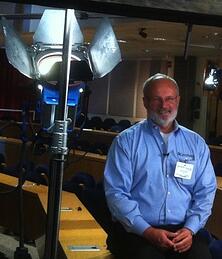Ask The Expert: Video For Trade Show Exhibiting
DAVID HOLROYD Founder of ECast Productions

British born David Holroyd has worked with video technology dating back to a time where some television output was still in black and white. He has lived in Boston since 1989 where he ran the sales and marketing operations for a series of local software companies. In 2005 he changed direction by attending Boston University’s Center for Digital Imaging Arts to study digital film and go on to start eCast Video in 2006 (now ECast Productions).
With all his experience and knowledge in video technology, Hill & Partners asked Holroyd to lend us some of his expertise on video content usage in regards to exhibiting at trade shows:
1) How does content created for trade shows differ from other marketing or company video content? Most corporate video content is viewed on the web or in a conference room. Research shows that on the web, good video can hold a person’s attention for about 90 seconds. In a conference room, a well-made corporate video that is appropriate to the audience can hold their attention for several minutes. In comparison, from a trade show aisle you have only a few seconds to grab the passerby’s attention.
Exhibitors need video content that gets their message across quickly: “this is who we are; this is what we do or what we make.” Trade shows are often noisy and people are sometimes twenty feet away when they see your large screen display. They can’t hear what’s being said in a video and they don’t usually start watching it from the beginning.
This content needs to be fast-paced, repetitive, visually exciting, and easily understood. If people are speaking on screen, you’ll want to have text overlays, so viewers in the aisles can understand what’s going on.
2) Are there times where an exhibitor is able to use a longer or audio-dependent video? Some trade show exhibits have a space where visitors can sit to watch scheduled events – executive speakers with slides for example. In this context you have the audience’s attention and, since there’s usually a PA system, they can hear what is being said. Here, your company’s general video collateral will work.
3) Why would you recommend investing in video production for exhibiting versus companies creating something internally, like a video loop or slideshow? Trade shows are expensive events. Ways to get the most value out of your investment: if you need video for other purposes (such as for your website or sales team), then you should be able to repurpose some of that collateral for use at trade shows. If you’re spending money on a custom professional exhibition stand with large LCD displays, and your company’s image matters, then you should be creating custom video collateral. It’s all about leveraging your assets.
4) Not all video is created equally. Why does the size and type of screen matter for what type of content should be created? Screen size and location depends on the size and layout of your stand. If the screen is close to and facing out into the aisle, and passing visitors are within 10 feet, then a 42” monitor screen will work well. If your screen is at the back of the booth, and therefore further from the passing traffic, it needs to be larger and higher. The booth designer (such as Hill & Partners) will take this into account.
As for content, no matter what it is (video or a slideshow) use an appropriate font size for text, something that an average passerby can read at 15 feet.
5) What guidelines do you suggest for devising objectives when it comes to content creation? In general, the content must fit its purpose. For a trade show, that means accessible, dynamic content. For events, the requirements will depend on the event. If your CEO is speaking at an industry conference, he needs high-level, forward looking, thought provoking content that will provide the background and a lead-in to his remarks.
Trade show video must adhere to the same brand guidelines as your other video collateral. If your video assets have the wrong branding, get your video vendor to update it.
6) How can an exhibitor utilize video content before, during, and after the show? Good video content should be easy to repurposed, and should be developed with a reasonable shelf life – typically eighteen months.
Before the event, the video can be used as a trailer to promote your attendance at the show, and to attract visitors to your booth.
7) What types of things should an exhibitor incorporate into their trade show booth video? Short clips from client testimonials, shots of your products in use or your staff at work, graphics showing the design or construction, short quotes from customers or industry experts, animated logos, beauty shots of products – these are all valuable components.
8) What are your thoughts on capturing video during the show? What kinds of things should exhibitors be capturing and how should they use that content? Trade shows are a great source for social media content. You can get quick sound-bytes from visitors and even client endorsements and have them on your Facebook and YouTube sites within a few hours. These days we usually send an editor with the crew to trade show events.
More:
Contact David Holroyd
Want to learn more about how to maximize your branding experience?

Disclaimer: Hill & Partners is dedicated to providing value for your business. The opinions, views and expertise contributed to this blog are credited to the "Ask the Expert" blog authors and do not represent the views of Hill & Partners, Inc.
Topics: From the Experts
